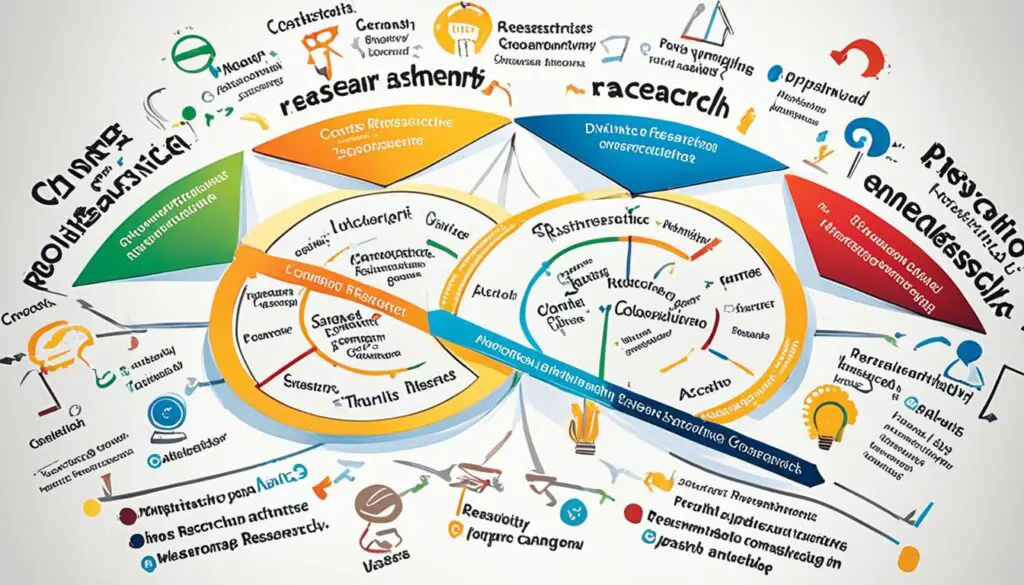Welcome to my blog. We’re chatting about action research and its classroom benefits. As teachers, we work hard to make our classes better. Action research offers a way to do this through a structured, reflective process.
Action research means looking into how we teach, what happens in the class, and how students do. We find spots of improvement through data and by looking at our teaching methods. Then, we choose to do things smarter, making the class better and helping students learn more.
Action research also pushes us to grow as professionals. It helps us see what we’re good at and where we need to improve. By using proven ways according to our research, we upgrade our teaching. This way, we leave a real mark on our students’ education.

Key Takeaways:
- Action research helps us improve classrooms and teaching methods.
- Data that tells us how we’re doing plays a huge role in this method.
- It lets teachers take control of their career and try new, tested methods.
- It’s a powerful way for teachers to make a big, positive difference in their classrooms.
- This method makes teaching and learning a well-thought, improving process.
The Action Research Cycle
The action research cycle helps teachers solve problems and improve. They follow steps to gather data, check the data, and make changes. This way, they can improve how they teach.
1. Identify Problem
Teachers start by picking a question or problem in their class. It must be something they can change and will help students learn better. Knowing the problem helps them focus on finding the right answer.
2. Develop Plan of Action
Next, they make a plan to deal with the problem. This plan says what they’ll do and when they’ll do it. It helps them see if their actions are working.
3. Collect Data
Collecting data is key. They can use many ways, like watching class, talking to students, and tests. This info shows what works and what doesn’t.
4. Analyze Data
After gathering data, teachers look at it to see what’s going well and what’s not. They look for trends and clues. This helps them know how to change their teaching.
5. Modify Theory
They then change how they teach. This means they rethink their methods and strategies. It’s all to help students learn in a better way.
6. Report Results
The last step is to tell others what they’ve found. Teachers share this with other teachers and leaders. It helps everyone teach better.
Following this action research cycle allows teachers to make meaningful changes. They take controlled steps to improve teaching. It aims to better the learning experience for students everywhere.

Different Types of Action Research
Action research is used in education to meet certain goals. It looks at classroom actions in unique ways. We’ll talk about three key action research types: positivist, interpretive, and critical.
1. Positivist Action Research
Positivist action research uses a scientific mindset. It depends on testing real-life theories. It uses hard data to confirm or disprove these ideas. Then, it gives insights into teaching, student success, and class atmospheres.
2. Interpretive Action Research
Interpretive action research looks at the meaning of education. It considers how context influences what we learn. It uses methods like talking to people, watching, and reading documents. This helps understand the unique views of everyone involved.
3. Critical Action Research
Critical action research is about big questions and change. It looks at power, fairness, and problems in education. This type asks why things are done a certain way. It wants to make a positive difference by challenging old ideas.
Teachers can pick these approaches to find out about their classrooms. Each type gives a different view. Together, they help make schools better and more fair for all.

| Action Research Type | Approach | Main Focus |
|---|---|---|
| Positivist Action Research | Quantitative | Evidence-based validation or refutation of hypotheses |
| Interpretive Action Research | Qualitative | Understanding the social construction of reality and contextual influences |
| Critical Action Research | Reflective and transformative | Critical examination of power dynamics and social justice issues |
Conclusion
Action research is a great tool for making positive changes in the classroom. It lets teachers like me look into our teaching, collecting data and studying our results. With this, we can make better choices for how we teach, aiming to solve problems and make learning better.
What’s really cool about action research is how it puts me in control of getting better at my job. I can spot where I need to improve and then use what I learn to teach even better. It gives me the power to make real changes in how my students learn, using different ways to figure out what works best.
Thinking about how I teach, gathering data, and then choosing how to improve has really upped my game. It’s let me get better at solving teaching problems and getting better results. Action research means I’m not just helping my students learn. I’m also learning and growing as a teacher.
FAQ
What is action research?
Action research helps teachers improve how they teach. It lets them look closely at their classrooms. Then, they can make changes to teach better.
How can action research help teachers?
It lets teachers check if their lessons work. They look at how students do. And they see if rules in the class help everyone learn.
What type of data does action research provide?
Action research gives teachers info about their lessons. They use this to make their teaching better. This info comes in the form of stories or opinions from students.
How does action research support professional development?
By doing action research, teachers learn new skills. They discover what works best in their classes. This helps them get better at their job.
What are the steps of the action research cycle?
The steps of action research are like a journey. First, teachers find a question. Then, they make a plan. They collect info, look at it, and share what they learned.
What methods can be used to collect data in action research?
Teachers can watch, talk to students, or check their work. They can also ask questions in surveys. These tools help teachers understand their classes better.
How can action research be categorized?
Action research has different styles. Some like facts and data (positivist). Others focus on what things mean (interpretive). And some push for big changes (critical).






